-
Views
-
Cite
Cite
Kimberly Sena Moore, Music Therapy Advocacy for Professional Recognition: A Historical Perspective and Future Directions, Music Therapy Perspectives, Volume 33, Issue 1, 2015, Pages 76–85, https://doi.org/10.1093/mtp/miu043
Close - Share Icon Share
Extract
The Merriam-Webster dictionary (2014) defines advocacy simply as “the act or process of supporting a cause or proposal.” Among healthcare professionals, advocacy can be a broad construct. It can happen on a micro level when a therapist helps a client access services (Dhillon, Wilkins, Law, Stewart, & Tremblay, 2010) or secure funding support (McCarty, 2009). Advocacy can also have an educational focus. This occurs on an individual level when, for example, one explains the importance of a particular profession and why it should be supported (Dhillon, Wilkins, Law, Stewart, & Tremblay, 2010; Mark, 2002), or an organizational level, as when an association launches a targeted public relations effort (Mark, 2002). There is also an aspect of advocacy that connects directly to legislative and policy issues, which occurs when an individual, group, or organization engages in lobbying efforts (Dhillon, Wilkins, Law, Stewart, & Tremblay, 2010; Palfrey, Cheng, & Schuster, 2011).
Advocating for the music therapy profession is a cornerstone of the State Recognition Operational Plan (SROP), a national initiative developed and implemented collaboratively by the American Music Therapy Association (AMTA) and the Certification Board for Music Therapists (CBMT). Since its launch in 2005, the SROP has resulted in a growing number of advocacy-related initiatives, including continuing education training on being an advocate, social media-focused efforts, Hill Day events at State Capitol buildings, and concurrent sessions at regional and national music therapy conferences. To some, it may seem as if these AMTA- and CBMT-initiated advocacy efforts are novel; however, educating the public about music therapy and establishing its credibility has been an intentional focus since the founding of the National Association for Music Therapy (NAMT) in 1950 (Michel, 2000; Solomon & Heller, 1982). In fact, all of the music therapy professional organizations and certifying bodies have contributed time, energy, and resources to advocating for and promoting music therapy in the United States (Davis, 1999; Anne Parker, personal communication, January 11, 2014). The SROP is not a reactive, stand-alone plan, but is an initiative built upon the advocacy foundation created by music therapy organizations in previous decades. Understanding organizational history is valuable, as it can offer a broader perspective and better understanding of current happenings, and can serve to more clearly explain complex ideas and events (Heller, 2000; Solomon & Heller, 1982). Thus, in order for music therapists and music therapy advocates to better understand the focus on state recognition for music therapy and their role in the initiative, the intention of this article is to create a historical narrative of advocacy activities conducted by the music therapy professional and credentialing organizations, then connect them to current efforts and future trends associated with the joint AMTA/CBMT State Recognition Operational Plan.





